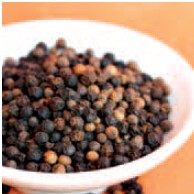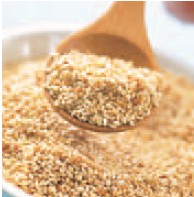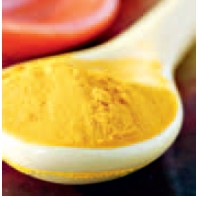Read Easy Indian Cooking Online
Authors: Hari Nayak
Easy Indian Cooking (8 page)
Paprika
Known as
Kashmiri mirch
in India, paprika is a red powder made from
dried, mild, non-pungent chili peppers. It is mainly used for the rich red color it adds to curries. When added to hot oil, it immediately releases a deep red color. Most Indian paprika comes from Kashmir, hence the name.
Kashmiri mirch
is available at Indian grocery stores or online. The easily available, mild Hungarian paprika is a good substitute.

Peppercorns
Peppercorns range in color from white, green to black. White peppercorns are picked ripe, and their outer skin is removed. Green peppercorns are under-ripe berries that are cured in brine. Black peppercorns are picked under ripe and allowed to dry until dark black. Black peppercorns are most commonly used and impart an incredible flavor to all curries. The world’s top quality black pepper is grown in Indian in the southwest coastal state of Kerala, and is known as
Tellicherry pepper
. The recipes in this book call for dry and oil-roasted, ground and crushed black peppercorns.
Pulses
see
Dried Legumes

Rice
Rice is an indispensible part of Indian meals. It is served as a staple alongside curries and dals and is eaten at least twice a day in India. There are many distinctive kinds of rice grown and sold in the Indian subcontinent. For everyday meals, the type of rice used depends varies from region to region. While the people in southern regions prefer the locally available red rice or long-grain variety, northerners prefer the aromatic Basmati rice, which grows in the foothills of the Himalayas.
Basmati, which means “queen of fragrance” in Hindi, is the most popular and the best-known rice of India, and it is the most expensive. It has a wonderful fragrance when cooked with whole spices and is a good match for all Indian dishes. Basmati rice is always used for
pulaos
and
biryanis
—two types of rice dishes—for it absorbs flavors beautifully and yet keeps its shape during cooking. Basmati rice, though preferred, is not absolutely necessary when making simpler rice preparations, such as Rosemary Lemon Rice (page 74) or Mint Pilaf with Potatoes and Toasted Cumin (page 78). Whereas Basmati rice needs to be soaked prior to being rinsed and drained, ordinary long-grain rice only needs to be rinsed and drained.

Saffron
These intense yellow-orange threads are the dried orange-to-deep-red stigmas of a small purple flower of the saffron crocus, a member of the iris family. It is the world’s most expensive spice as it takes almost 75,000 handpicked blossoms to make one pound of saffron. Use saffron sparingly as it just takes four to five strands of saffron to flavor a dish that feeds four. It has a distinctly warm, rich, powerful and intense flavor. It is available in strands or ground. I recommend the strands for the sake of more assured quality. Gently heat saffron on a dry skillet before using as heat brings out its aroma. There is no acceptable substitute for saffron. Saffron is available in Indian or Middle Eastern grocery stores, gourmet stores and online.
Salt
The most common salt that is used in North America is table salt. It is very fine in texture and is often supplemented with iodine. Table salt, when compared to kosher or sea salt, is much saltier. Sea salt is the most popular salt used in Indian cooking. Measurements used in the recipes in this book are for common table salt. If you prefer to use kosher salt or sea salt, you will most likely need to increase the amount of salt by 10 to 15 percent. However, it is always a good idea to taste and check for seasoning before adding more.

Sesame Seeds
These tiny seeds are harvested from a flowering plant found in tropical regions around the world and is cultivated for its edible seeds. Whole or ground white sesame seeds are used in savory Indian dishes, breads and many sweets. Sometimes the seeds are toasted to heighten their nutty flavor. They come in a host of different colors, depending upon the variety, including white, yellow, black and red. In general, the paler varieties of sesame are used in the West and Middle East, while the black varieties are more common in the East. They are available in most grocery stores.

Star Anise
This dried, star-shaped, dark-brown pod contains licorice-flavored seeds. The pods grow on an evergreen tree that is a member of the magnolia family. Star anise is used to flavor and add an enticing aroma to both sweet and savory dishes. It is often used on its own or ground with different spices to make blends. This spice is available at Indian and Asian grocery stores, online and at many conventional supermarkets.

Tamarind
Tamarind is the curved brown bean pod of the tamarind tree. The pod contains a sticky pulp enclosing one to twelve shiny black seeds. It is the pulp that is used as a flavoring for its sweet-and-sour fruity aroma and taste. It is used in chutneys, preserves and curries. Tamarind is available in South Asian grocery stores, natural foods stores, and some conventional supermarkets in one or more of the following three ways: in pod form, pressed into a fibrous dried slab, or in jars of tamarind “paste” or “concentrate,” which has a jam-like consistency. I call for the tamarind paste in the recipes in this book simply because it is the most convenient form to use and is fairly easy to find.
Alternatively to create tamarind juice from the dried slab, soak a walnut-size chunk of the dried pulp (this is equivalent to 1 teaspoon of tama-rind paste) in ½ cup (125 ml) of warm water for 15 minutes. After soaking the pulp in water, break it up with your fingers, and then mash it with a fork until the liquid is muddy brown in appearance. Strain this mixture before use through a fine-mesh strainer. Using the back of spoon, mash and push the pulp through the fine-mesh strainer to extract any remaining juice.

Turmeric
It is a rhizome of a tropical plant in the ginger family. The fresh root is boiled, peeled, sun-dried, and ground into a bright yellow-orange powder. Ground turmeric has a warm, peppery aroma—reminiscent of ginger—and a strong, bitter taste, which mellows upon cooking. It is used to color many curries and is sometimes used as a “poor man’s substitute” for saffron due to the similar color it imparts; however, the taste is quite different.
Yogurt
Thick and creamy yogurt is made every day in homes across the Indian subcontinent and it is an important part of every meal. It is most commonly enjoyed plain as a mild contrast to spicy foods.
Raitas
—cooling salads made with yogurt and crunchy vegetables—are very popular. Yogurt is often churned into cooling drinks with spices, and is the base for many desserts. In savory cooking, its main role is as a souring agent, though it also aids digestion. In India it is customary to end a meal with either plain yogurt mixed with rice or a glass of Indian spiced “buttermilk” (thinned yogurt with salt, green chilies, ginger and salt which is common in south India). The best yogurt to use for the recipes in this book is a thick, plain, natural yogurt made from whole milk. Look for organic whole milk yogurt for the best consistency and flavor.
